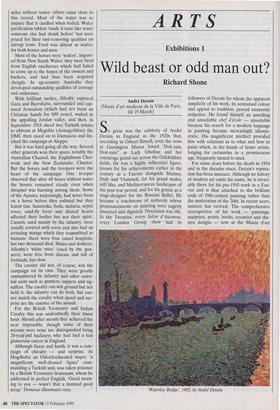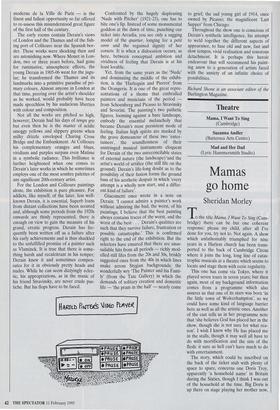ARTS
Exhibitions 1
Wild beast or odd man out?
Richard Shone
Andre Derain (Musee d'art moderne de la Ville de Paris, till 19 March)
So great was the celebrity of Andre Derain in England in the 1920s that, according to Osbert Sitwell, even the cows at Garsington Manor lowed Doe-rain, Doe-rain!' as Lady Ottoline and her entourage gazed out across the Oxfordshire fields. He was a highly influential figure, known for his achievements earlier in the century as a Fauvist alongside Matisse, Dufy and Vlaminck, for his grand nudes, still lifes, and Mediterranean landscapes of the post-war period, and for his genius as a stage-designer for the Russian Ballet. He became a touchstone of authority whose pronouncements on painting were eagerly dissected and digested. Derainism was rife. In the Twenties, every Salon d'Automne, every London Group show had its followers of Derain for whom the apparent simplicity of his work, its restrained colour and appeal to tradition, proved eminently seductive. He found himself an unwilling and unsuitable chef d'ecole — unsuitable because his search for a modern language in painting became increasingly idiosyn- cratic. His magnificent intellect provided him with solutions as to what and how to paint which, in the hands of lesser artists, longing for certainties in a promiscuous age, frequently turned to mud.
For some years before his death in 1954 and in the decades since, Derain's reputa- tion has been insecure. Although no history of modern art omits his name, he is invari- ably there for his pre-1910 work as a Fau- vist and is thus attached to the brilliant coda of 19th-century painting rather than the modernism of the 20th. In recent years, interest has revived. The comprehensive retrospective of his work — paintings, sculpture, prints, books, ceramics and the- atre designs — now at the Musee d'art `Waterloo Bridge', 1905, by Andre Derain moderne de la Ville de Paris — is the finest and fullest opportunity so far offered to re-assess this misunderstood great figure of the first half of the century.
The early rooms contain Derain's views of London and the Thames and of the fish- ing port of Collioure near the Spanish bor- der. These works were shocking then and are astonishing now. Where Monet in Lon- don, two or three years before, had gone for ruminative, atmospheric effects, the young Derain in 1905-06 went for the jugu- lar; he transformed the Thames and its landmarks into a primitive paradise of pri- mary colours. Almost anyone in London at that time, peering over the artist's shoulder as he worked, would probably have been made speechless by his audacious liberties with colour and composition.
Not all the works are pitched so high, however; Derain had his days of temps grin but even then he is the master of acidic smoggy yellows and slippery greens when milky drizzle enveloped Charing Cross Bridge and the Embankment. At Collioure his complementary oranges and blues, viridians and purples surpass even Matisse in a symbolic radiance. This brilliance is further heightened when one comes to Derain's later works in which he sometimes employs one of the most sombre palettes of any significant 20th-century artist.
For the London and Collioure paintings alone, the exhibition is pure pleasure. For addicts, like myself, of the later, less well- known Derain, it is essential. Superb loans from distant collections have been secured and, although some periods from the 1920s onwards are thinly represented, there is enough on view to gain the measure of his grand, erratic progress. Derain has fre- quently been written off as a failure after his early achievements and is thus shackled to the unfulfilled promise of a painter such as Vlaminck. It is true that there is some- thing harsh and recalcitrant in his temper; Derain knew it and sometimes compen- sates for it in obviously pretty heads and nudes. While he can seem dizzyingly eclec- tic, his appropriations, as in the music of his friend Stravinsky, are never crude pas- tiche. But his flops have to be faced. Confronted by the hugely displeasing `Nude with Pitcher' (1921-23), one has to bite one's lip. Instead of some monumental goddess at the dawn of time, punching our ticket into Arcadia, you see only a sagging model of the quartier, longing for a petit verre and the regained dignity of her corsets. It is when a dislocation occurs, as here, between conceptual ambition and vividness of feeling that Derain is at his least lovable.
Yet, from the same years as the 'Nude' and dominating the middle of the exhibi- tion, is the 'Harlequin and Pierrot' from the Orangerie. It is one of the great repre- sentations of a theme that enthralled painters and musicians of the period from Schoenberg and Picasso to Stravinsky and Severini. The painting's two pathetic figures, looming against a bare landscape, embody the essential melancholy that became Derain's most persistent mode of feeling. Italian high spirits are masked by the grave demeanour of these two 'enter- tainers', the soundlessness of their unstringed musical instruments eloquent for Derain of the two unreconcilable states of external nature (the landscape)'and the artist's world of artifice (the still life on the ground). Derain's life-long doubt as to the possibility of their fusion forms the ground bass of his aesthetic despair in which 'every attempt is a wholly new start, and a differ- ent kind of failure'.
Giacometti once wrote in a note on Derain: 'I cannot admire a painter's work without admiring the bad, the worst, of his paintings; I believe that the best painting always contains traces of the worst, and the worst of the best . . . Derain's qualities are such that they survive failure, frustration or possible catastrophe.' This is confirmed right to the end of the exhibition. But the selectors have ensured that there are unas- sailable hits from all periods — richly mod- elled still lifes from the 20s and 30s, briskly suggested ones from the 40s in which lines snake across Stygian backgrounds; the wonderfully wry 'The Painter and his Fami- ly' (from the Tate Gallery) in which the demands of solitary creation and domestic life — 'the pram in the hall' — nearly come HARott NTEe'S \JOE° P1,01-16 to grief; the sad young girl of 1914, once owned by Picasso; the magnificent 'Last Supper' from Chicago.
Throughout the show one is conscious of Derain's synthetic intelligence, his attempt to weld together the different aspects of appearance, to fuse old and new, fast and slow tempos, vivid realisation and sonorous detachment. It is perhaps this heroic endeavour that will recommend his paint- ing anew to a generation of artists faced with the anxiety of an infinite choice of possibilities.
Richard Shone is an associate editor of the Burlington Magazine.



























































 Previous page
Previous page